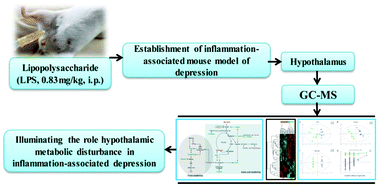当前位置:
X-MOL 学术
›
Mol. Biosyst.
›
论文详情
Our official English website, www.x-mol.net, welcomes your feedback! (Note: you will need to create a separate account there.)
Imbalance in amino acid and purine metabolisms at the hypothalamus in inflammation-associated depression by GC-MS
Molecular BioSystems Pub Date : 2017-10-25 00:00:00 , DOI: 10.1039/c7mb00494j Yu Wu 1, 2, 3, 4 , Yonghong Li 1, 2, 3, 4 , Yanjuan Jia 1, 2, 3, 4 , Chaojun Wei 1, 2, 3, 4 , Hui Xu 1, 2, 3, 4 , Rui Guo 1, 2, 3, 4 , Yuanting Li 1, 2, 3, 4 , Jing Jia 1, 2, 3, 4 , Xiaoming Qi 1, 2, 3, 4 , Xiaoling Gao 1, 2, 3, 4
Molecular BioSystems Pub Date : 2017-10-25 00:00:00 , DOI: 10.1039/c7mb00494j Yu Wu 1, 2, 3, 4 , Yonghong Li 1, 2, 3, 4 , Yanjuan Jia 1, 2, 3, 4 , Chaojun Wei 1, 2, 3, 4 , Hui Xu 1, 2, 3, 4 , Rui Guo 1, 2, 3, 4 , Yuanting Li 1, 2, 3, 4 , Jing Jia 1, 2, 3, 4 , Xiaoming Qi 1, 2, 3, 4 , Xiaoling Gao 1, 2, 3, 4
Affiliation

|
Hypothalamic dysfunction is a key factor in depression; increasing evidence highlights neuroinflammation abnormalities as well as imbalances in neurotransmitters and the purinergic system in the pathophysiology of depression. However, little is known about the metabolomic changes in the hypothalamus of depressed patients with neuroinflammation. Herein, taking advantage of the well-established lipopolysaccharide (LPS)-induced depression mouse model, we measured metabolic changes in the hypothalamus using gas chromatography-mass spectrometry (GC-MS). Sucrose preference test (SPT), open field test (OFT), forced swimming test (FST), and tail suspension test (TST) were conducted to assess our depressive model. To better understand the metabolic disturbances occurring in the hypothalamus of depressed mice, multivariate statistics were applied to analyse the clinical significance of differentially expressed metabolites in the hypothalamus of mice with LPS-induced depression. Bioinformatic analysis was conducted to detect potential relationships among the changed metabolites. The data confirmed that mice with LPS-induced depression were good mimics of depression patients in some characteristic symptoms such as decreased sucrose intake and increased immobility. In our study, 27 differentially expressed metabolites were identified in the hypothalamus of mice with LPS-induced depression. Herein, seventeen of these metabolites decreased, whereas 10 metabolites increased. These molecular changes were closely related to perturbations in the amino acid and purine metabolisms. Our data indicate that dysfunction of amino acid and purine metabolisms is one of main characteristics of inflammation-mediated depression. These results provide new insights into the mechanisms underlying depression, which may shed some light on the role of the hypothalamus in the pathogenesis of inflammation-mediated depression.
中文翻译:

GC-MS在炎症相关性抑郁症下丘脑氨基酸和嘌呤代谢失衡
下丘脑功能障碍是抑郁症的关键因素。越来越多的证据表明,神经炎症异常以及抑郁症的病理生理中神经递质和嘌呤能系统的失衡。然而,关于抑郁症的神经炎症患者下丘脑的代谢组学变化知之甚少。在这里,我们利用成熟的脂多糖(LPS)诱导的抑郁症小鼠模型,使用气相色谱-质谱(GC-MS)测量了下丘脑的代谢变化。进行了蔗糖偏爱测试(SPT),开放视野测试(OFT),强迫游泳测试(FST)和尾部悬浮测试(TST)来评估我们的抑郁模型。为了更好地了解抑郁小鼠下丘脑中发生的代谢紊乱,应用多变量统计数据分析LPS诱发的抑郁症小鼠下丘脑中差异表达代谢物的临床意义。进行了生物信息学分析,以检测变化的代谢物之间的潜在关系。数据证实,LPS诱发的抑郁症小鼠在某些特征性症状(如减少蔗糖摄入和固定性增加)方面是抑郁症患者的良好模仿。在我们的研究中,在LPS诱发的抑郁症小鼠的下丘脑中鉴定出27种差异表达的代谢产物。在此,这些代谢物中的十七种减少,而十种代谢物增加。这些分子变化与氨基酸和嘌呤代谢的扰动密切相关。我们的数据表明氨基酸和嘌呤代谢功能异常是炎症介导的抑郁症的主要特征之一。这些结果为了解抑郁症的潜在机制提供了新见解,这可能为下丘脑在炎症介导的抑郁症发病机理中的作用提供了一些启示。
更新日期:2017-11-13
中文翻译:

GC-MS在炎症相关性抑郁症下丘脑氨基酸和嘌呤代谢失衡
下丘脑功能障碍是抑郁症的关键因素。越来越多的证据表明,神经炎症异常以及抑郁症的病理生理中神经递质和嘌呤能系统的失衡。然而,关于抑郁症的神经炎症患者下丘脑的代谢组学变化知之甚少。在这里,我们利用成熟的脂多糖(LPS)诱导的抑郁症小鼠模型,使用气相色谱-质谱(GC-MS)测量了下丘脑的代谢变化。进行了蔗糖偏爱测试(SPT),开放视野测试(OFT),强迫游泳测试(FST)和尾部悬浮测试(TST)来评估我们的抑郁模型。为了更好地了解抑郁小鼠下丘脑中发生的代谢紊乱,应用多变量统计数据分析LPS诱发的抑郁症小鼠下丘脑中差异表达代谢物的临床意义。进行了生物信息学分析,以检测变化的代谢物之间的潜在关系。数据证实,LPS诱发的抑郁症小鼠在某些特征性症状(如减少蔗糖摄入和固定性增加)方面是抑郁症患者的良好模仿。在我们的研究中,在LPS诱发的抑郁症小鼠的下丘脑中鉴定出27种差异表达的代谢产物。在此,这些代谢物中的十七种减少,而十种代谢物增加。这些分子变化与氨基酸和嘌呤代谢的扰动密切相关。我们的数据表明氨基酸和嘌呤代谢功能异常是炎症介导的抑郁症的主要特征之一。这些结果为了解抑郁症的潜在机制提供了新见解,这可能为下丘脑在炎症介导的抑郁症发病机理中的作用提供了一些启示。


























 京公网安备 11010802027423号
京公网安备 11010802027423号